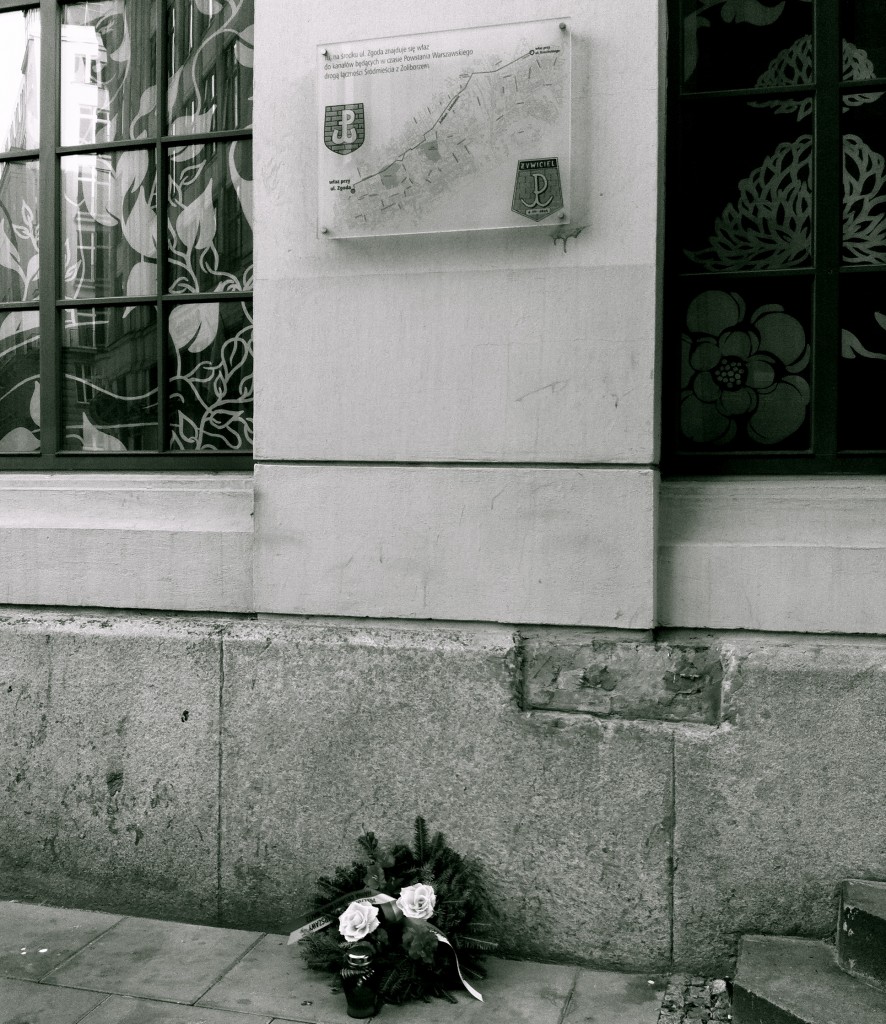In Warsaw, the dead are everywhere. On street corners, in parks and in mass graves, long buried under apartment blocks and skyscrapers.
My interest in the Warsaw Uprising (powstanie warszawskie) was the main reason that I came here, besides the fact that my train to Moscow leaves from Warsaw Central. Living in Berlin, I am used to being confronted with World War II- and Cold War-history every day. Berlin however seems to remember the past in a centralised way: there’s the holocaust memorial, the memorial to the resistance against Hitler and so forth. In Warsaw, memorials to fallen soldiers are on every street corner, little badges indicating the names of the fighters and their units, all adorned with candles, flags and flowers due to the anniversary of the rising on August 1st.
I had underestimated the influence of the Uprising. Where Berlin is a city where you need to understand the multiple layers of history and events that shape the city today, everything in Warsaw today originates in this one watershed: the final rising of pre-1939 Poland fighting against Nazi Germany as free people. And the subsequent destruction of the whole city following the perfidious plan of Hitler and Himmler. The Germans did not even use explosives (none to spare as all are needed for the front), but instead deployed so-called ‘Brennkommandos‘, burn squads using flame throwers to burn down house after house.
Besides the countless little memorials, the most spine-chilling things I encountered were graffiti of the kotwica or anchor emblem used by the Polish resistance; some on newer buildings seemingly not connected to the Uprising. It looked as if the dead fighters had painted them overnight, reminding us to not forget them.
—
In Warschau sind die Toten überall. An Strassenecken, in Parks und in Massengräbern, lange verborgen unter Apartmentblöcken und Wolkenkratzern.
Der Warschauer Aufstand 1944 war, neben der Tatsache dass der Zug nach Moskau hier abfährt, der Hauptgrund für meinen Besuch der Stadt. In Berlin wird man oft mit der Vergangenheit konfrontiert, wenn auch mehr zentralistisch: Es gibt ein Holocaust-Denkmal, ein Denkmal für den Widerstand gegen Hitler und so weiter. In Warschau sind die Denkmäler in fast jeder Strasse, kleine Plaketten mit den Namen der gefallenen Kämpfer und ihrer Einheit, im Rahmen des Jahrestages am 1. August geschmückt mit Trauerkerzen, kleinen Flaggen und Blumen.
Auch hatte ich den Einfluss des Aufstandes auf Warschau heute unterschätzt. Wo Berlin heute nur aus verschiedenen Schichten und Einflüssen bestehend verstanden werden kann, lässt sich in Warschau alles auf dieses eine Ereignis zurück führen: das letzte Aufbäumen der polnischen Republik von 1939 und ein Aufstand eines freien Polen. Und die darauf folgende komplette Zerstörung der Stadt nach einem persönlichen Plan Hitlers und Himmlers. Warschau wurde nicht mit Sprengstoff zerstört, der wurde ja für die Front benötigt, sondern von sogenannten Brennkommandos, Soldaten mit Flammenwerfern die die Stadt Haus für Haus niederbrannten.
Am meisten zum Nachdenken gebracht haben mich aber die vielen Graffitis des kotwica oder “Anker”-Symbole der polnischen Widerstandskämper an Häusern in der Stadt, die auf den ersten Blick nichts mit dem Aufstand zu tun haben. Als hätten die Toten selber die Symbole angebracht, damit wir sie nicht vergessen.
